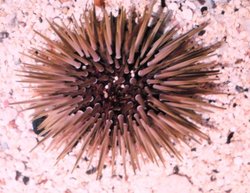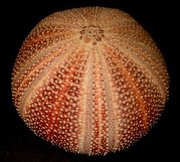Sea urchin
|
|
| Sea Urchins | ||||||
|---|---|---|---|---|---|---|
 A Sea urchin | ||||||
| Scientific classification | ||||||
| ||||||
| Subclasses | ||||||
|
Coarsespinedseaurchinsm.jpg
Sea_urchin_eggs.jpg
Urchintest2.jpg
Sea urchins are spiny sea creatures of the class Echinoidea found in oceans all over the world. (The name sea urchin means sea hedgehog, hedgehog being one meaning of the word urchin). Their shell, which biologists call the test, is globular in shape, and covered with spines. The size of the test in adults is typically in the range of 3 to 10 cm.
Typical sea urchins have spines 1-2 cm in length (e.g. "Sea urchin", right), a millimeter or two thick, and not terribly sharp. Diadema antillarum, familiar in the Caribbean, has thin spines that can be 10-20 cm long. Sea urchins are usually dull in color, common colors including green, olive, brown, purple, and black.
Sea urchins are echinoderms (phylum Echinodermata), which also includes starfish, sea cucumbers, Brittle-stars, and crinoids. Like other echinoderms they have five-fold or pentamerous radial symmetry and move by means of hundreds of tiny, transparent, adhesive "tube feet." The pentamerous symmetry is not obvious at a casual glance, but is easily seen in the dried shell of the urchin (see picture below, right).
Within the echinoderms, sea urchins are classified as echinoids (class Echinoidea). Specifically, the term "sea urchin" refers to the "regular echinoids," which are symmetrical and globular. The ordinary phrase "sea urchin" actually includes several different taxonomic groups: the Echinoida and the Cidaroida or "slate-pencil urchins", which have very thick, blunt spines (see image at right), and others (see taxobox). Besides sea urchins, the Echinoidea also includes three groups of "irregular" echinoids: flattened sand dollars, sea biscuits, and heart urchins.
At first glance a sea urchin often appears to be an inanimate object, or one which is incapable of moving. Sometimes the most visible sign of life is the spines, which are attached at their bases to ball-and-socket joints and can be pointed in any direction. In most urchins, a light touch elicits a prompt and visible reaction from the spines, which converge toward the point that has been touched. A sea urchin has no visible eyes, legs or means of propulsion, but it can move freely over surfaces by means of its adhesive tube feet, working in conjunction with its spines.
On the oral surface of the sea urchin is a centrally located jaw. It is surrounded by five horny teeth. The entire chewing organ is known as Aristotle's lantern. The name comes from Aristotle's accurate description in his History of Animals:
- ...the urchin has what we may call its head and mouth down below, and a place for the issue of the residuum up above. The urchin has, also, five hollow teeth inside, and in the middle of these teeth a fleshy substance serving the office of a tongue. Next to this comes the oesophagus, and then the stomach, divided into five parts, and filled with excretion, all the five parts uniting at the anal vent, where the shell is perforated for an outlet... In reality the mouth-apparatus of the urchin is continuous from one end to the other, but to outward appearance it is not so, but looks like a horn lantern with the panes of horn left out. (Tr. D'Arcy Thompson)
The spines, which in some species are long and sharp, serve to protect the urchin from predators. Sea urchins feed mainly on algae. The spines can inflict a painful wound on a human who steps on one, but they are not seriously dangerous and it is not clear that the spines are truly venomous (unlike the pedicellariae between the spines, which are).
Sea urchin is one of the favorite foods of sea otters. Recently the population of sea otters in the Monterey Bay of California has diminished. As a result, the population of sea urchins has multiplied and they are chewing up the kelp forest in the area and upsetting the ecosystem.
Humans consume the reproductive organs ("roe") either raw or briefly cooked. Sea urchin roe is a popular food in Korean cuisine, and it is called "uni" in Japanese sushi cuisine.
The bare shells ("tests") of sea urchins are sometimes found on beaches, and are often sold in seaside souvenir shops. Dropping a sea urchin into ordinary household bleach quick removes the spines and flesh substance, leaving a clean test. The test has a dramatic geometrical beauty and looks utterly unlike the familiar molluscan seashells.
Pluteus001.jpg
The sea urchin occupies a special place in biology due to its long-time use as a standard subject for studies in embryology. The sea urchin, particularly Arbacia punctulata, is the source of textbook descriptions of "the" egg, "the" embryo, and their early development. Theodor Boveri studied two species of sea urchin and concluded that all chromosomes were needed for normal embryonic development. At the Marine Biological Laboratory at Woods Hole, the Arbacia egg achieved almost the status of a standard "living cell" for physiological, biochemical and cytological work—resulting, of course, in overfishing and, in 1945, the near-extinction of the local Arbacia population. Sea urchins are a favored organism for studies of development using a systems biology [1] (http://www.ncbi.nlm.nih.gov/entrez/query.fcgi?cmd=Retrieve&db=pubmed&dopt=Abstract&list_uids=11872831)approach, often in conjunction with gene knockdown studies using Morpholino antisense oligos [2] (http://www.ncbi.nlm.nih.gov/entrez/query.fcgi?cmd=Retrieve&db=pubmed&dopt=Abstract&list_uids=12578984).
Since the sea urchin is globular and radially symmetrical, and since like other organisms its early embryological stages are globular and radially symmetrical, it is surprising that its larval stage, known as a pluteus, is not. The pluteus exhibits only bilateral symmetry. (Pluteus is Latin for "easel," to which the larvae of some species really do show a close resemblance). During development, the sea urchin must transform first itself from having radial to bilateral symmetry, and then again from having bilateral to radial symmetry.
A group of pluteus larvae viewed under a dissecting microscope between crossed polarizers is a dramatic sight. The entire larva, including the calcareous skeleton, is transparent. However, the skeleton is birefringent. The result is that only the skeleton becomes visible--in glowing rainbow colors which change as the swimming larva changes its orientation with respect to the polarizers.
Geological history
The earliest known echinoids are found in the rocks of the upper part of the Ordovician period, and they have survived to the present day where they are a successful and diverse group of organisms. In well preserved specimens the spines may be present, but usually only the test is found. Sometimes isolated spines are common as fossils. Some echinoids (such as Tylocidaris clavigera which is found in the Cretaceous period Chalk Formation of England) had very heavy club-shaped spines that would be difficult for an attacking predator to break through and make the echinoid awkward to handle. Such spines are also good for walking on the soft sea-floor.
Fossil_Echinoid_Lovenia.jpg
Complete fossil echinoids from the Paleozoic era are generally rare, usually consisting of isolated spines and small clusters of scattered plates from crushed individuals. Most specimens occur in rocks from the Devonian and Carboniferous periods. The shallow water limestones from the Ordovician and Silurian periods of Estonia are famous for the echinoids found there. The Paleozoic echinoids probably inhabited relatively quiet waters. Because of their thin test they would certainly not have survived in the turbulent wave-battered coastal waters inhabited by many modern echinoids today. During the upper part of the Carboniferous period there was a marked decline in echinoid diversity and this trend continued into the Permian period. They neared extinction at the end of the Paleozoic era, with just six species known from the Permian period.
By the upper part of the Triassic period their numbers began to increase again. The echinoids diversified into many types throughout the Jurassic period and into the Cretaceous period. During the Mesozoic and Cenozoic eras the echinoids flourished. However most echinoid fossils are restricted to certain localities and formations, but where they do occur they are quite often abundant. An example of this is Enallaster which may be collected by the thousand in certain outcrops of limestone from the Cretaceous period in Texas.
Some echinoids (such as Micraster which is found in the Cretaceous period Chalk Formation of England and France) serve as zone (or index) fossils. As they evolved rapidly over time such fossils are useful in enabling geologists to date the rocks in which they are found. However, most echinoids are not abundant enough and may be too limited in their geographic distribution to serves as zone fossils.
References and further reading
- Andrew Smith. Echinoid Palaeobiology. George Allen and Unwin, 1984.
- Animal Diversity Web Classification of the Echinoidea (http://animaldiversity.ummz.umich.edu/site/accounts/classification/Echinoidea.html#Echinoidea)da:Søpindsvin
de:Seeigel fr:Oursin ja:ウニ nl:Zee-egel pt:Echinoideapl:Jeżowce


